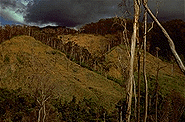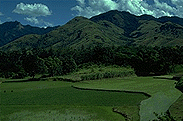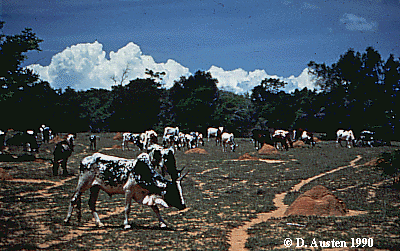

Rice paddies near Eminyminy, looking toward forested slopes in the Andohahela Strict Nature Reserve
Although the native vegetation of Madagascar is of greatest interest to most scientists by virtue of its diversity and endemism, and its fundamental role in understanding patterns of evolution and phytogeography, anthropogenic vegetation is nevertheless very important, if for no other reason than the fact that it occupies such a huge part of the country. For the purposes of classification, areas under intensive cultivation can be treated together, including rice paddies or agricultural crops such as cotton or tobacco, and also tree plantations, or cash crops such as cloves or litchis.
Hill rice cultivation within the Manongarivo Special Reserve
Cultivation in Madagascar also involves slash and burn agriculture, (tavy), in which native forest -- especially evergreen forest -- is cleared and burned, and various crops, mostly dry land rice, are planted for a few years, until the soils are depleted, and then abandoned. This process is responsible for the destruction of tens of thousands of hectares of intact forest each year (see Green and Sussman, 1990).
Natural regeneration along forest edge in the Manongarivo Special Reserve
Colonizing species, including woody plants such as Harongana madagascariensis, then form a secondary thicket (fourré secondaire) that is very species poor. If left alone this vegetation will develop into a low diversity secondary forest. But usually it is cut and burned again for another round of cultivation, and after a few such cycles, the vegetation reaches the end point of a degradation series, an impoverished secondary grassland.
In the central and western parts of Madagascar (the High Plateau) vast expanses of secondary grassland now cover nearly the entire landscape.
They are subjected to regular, annual burning, and are of little use for agriculture or grazing. At the start of the 20th Century some thought that these so called "prairies" were a native form of vegetation, but Perrier de la Bâthie, (1921) Humbert (1949, 1955, 1965), and most recent workers have regarded them as anthropogenic.
These grasslands stand out in being remarkably poor in species, with perhaps as few as half a dozen taxa present in a given area -- far fewer than one normally encounters in native vegetation. Furthermore, they contain very few native fire-adapted plants, and those that are present also occur as a natural component of woody vegetation, and were clearly pre-adapted to survive in the newly formed secondary grasslands. Examples of such species include the palm Bismarkia nobilis and Uapaca bojeri (Euphorbiaceae) ("Tapia"). Careful analysis of Bosser's (1969) study of Malagasy grasses shows that of 288 species of indigenous or naturalized Poaceae, 214 occur in grasslands (both native and secondary), of which 90 species (42%) are endemic to Madagascar. Of these 90 taxa, 65 (72%) also occur in various other natural habitats (forests, wetlands, deciduous thickets, etc.). This leaves a total of only 25 species confined to grasslands, eight of which are restricted to the higher mountains, with just 17 species (representing only 8% of the entire grassland Poaceae flora) occurring principally in the low and mid-elevation grasslands that cover an estimated 420,000 kmę (ca. 72%) of Madagascar's total land surface (Koechlin et al., 1974). Of these 17 grassland endemics, many have localized distributions and represent relatively minor components of the flora. If these formations were natural, they would be expected to contain a more diverse native grass flora, and endemism at the species level would at least approach that for the angiosperm flora as a whole (ca. 70-80%).
Some recent authors have questioned how such huge areas of vegetation could have been degraded and converted to secondary grassland so quickly after the arrival of humans on Madagascar perhaps 2,000 years ago (Burney 1987a, 1987b, 1987c, 1993, in press; Burney et al., 1986; MacPhee et al, 1985; Matsumoto and Burney, 1994). They contend instead that most of these areas were covered with a mosaic of dry forest and grassland from ca. 3,500 to 1,200 year ago, and that the vegetation seen today essentially represents a degraded form of the original climax vegetation. This interpretation is set in contrast to the co-called "classical hypothesis" of Perrier de la Bâthie (1921, 1936) and Humbert (1927, 1949, 1955), which is said to hold that Cenozoic Madagascar was covered with essentially continuous, dense, climax forest prior to the arrival of humans -- a sort of paradise of unbroken rain forest. This so-called "classical hypothesis" is, however, nothing more than a straw man. Perrier de la Bâthie clearly recognized that a mosaic of vegetation types probably existed prior to human arrival, and neither he nor Humbert ever suggested that unbroken rain forest covered the entire island. Rather, the flora and vegetation that once occupied the areas now covered with secondary grassland was characterized as follows (Perrier de la Bâthie 1921, p. 61, our translation): "The original flora was a totally forest flora. But by these words I do not mean that the whole island was previously covered with dense forests. No, such forests were localized in the plains, valleys, on the plateaux, and in certain regions only. Elsewhere, [the vegetation] was a tall shrubland, with twisted trees, and in the driest regions, islands of xerophyllous plants occurred. Herbaceous or annual plants were numerous, but all were forest dwellers, and grew in the shade of the trees and shrubs."
It is important to note that Perrier de la Bâthie's definition of a "forest flora" is an assemblage that includes both woody and herbaceous elements, and thus encompases several types of woody vegetation -- such as shrubland and bushland -- which are more open than true forests in the strict sense. He was clearly describing a mosaic of primarily woody formations intermixed with some herbaceous elements, which is consistent with the views of Burney (1987b, in press; see also Dewar 1984). Considerable debate, however, surrounds the question of how much grassland was present when human's first started impacting the Malagasy environment. We believe that true grassland was a minor component of the vegetation, an interpretation that is in fact completely consistent with the data that Burney and his colleagues have published, which show grass pollen counts of about 5-20% just prior to the first major spikes of charcoal in their lake cores, about 2,000 years ago, when people first arrived in Madagascar -- as compared to counts of 40-90% for true grasslands (Burney, 1987b, 1988, 1993; see also Hamilton, 1982). Much of the huge area now covered with secondary grassland thus originally had a woody vegetation cover -- NOT forest in the strict sense for the most part, but rather more open vegetation types (woodland, bushland, shrubland, etc.), which were subjected to occasional fires that no doubt had an important impact on them. Moreover, these areas of woody vegetation were in a state of dynamic equilibrium, a very fragile equilibrium in many areas, especially in the center and west, where there is an extended dry season. This situation was further accentuated on sites with edaphic conditions that were not particularly favorable for the maintenance of a forest cover, such as on some compact clay soils (Morat, 1973). With the arrival of man, and the advent of more frequent burning, a threshold was crossed, beyond which the irreversible degradation of these habitats took place. In areas where the equilibrium maintaining woody vegetation was particularly fragile (e.g., the Horombe Plateau; see Morat, 1969), the balance could have been tipped very easily, altering large areas without anyone necessarily having to swing a single axe. In the moister east-central part of the island, however, the woody vegetation was almost surely more stable, and its transformation to secondary grassland required more active human intervention (clearing), and would thus have been possible only after population densities had surpassed a threshold level some time later,

a process that was no doubt accelerated by the presence of huge herds of grazing zebu cattle, whose numbers may be greater than Madagacar's entire human population.